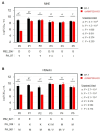Chicken ANP32A-independent replication of highly pathogenic avian influenza viruses potentially leads to mammalian adaptation-related amino acid substitutions in viral PB2 and PA proteins
- PMID: 39570060
- PMCID: PMC11784356
- DOI: 10.1128/jvi.01840-24
Chicken ANP32A-independent replication of highly pathogenic avian influenza viruses potentially leads to mammalian adaptation-related amino acid substitutions in viral PB2 and PA proteins
Abstract
Acidic nuclear phosphoprotein 32 family member A (ANP32A) is an important host factor that supports the efficient replication of avian influenza viruses (AIVs). To develop an antiviral strategy against Gs/Gd-lineage H5 highly pathogenic avian influenza (HPAI) viruses in chickens, we established chicken ANP32-knockout (chANP32A-KO) DF-1 cells and evaluated their antiviral efficacy through in vitro validation. The replication of all HPAI viruses tested in chANP32A-KO cells was significantly lower compared to that of wild-type DF-1 cells. However, when HPAI strains A/mountain hawk-eagle/Kumamoto/1/2007 (H5N1; MHE) and A/chicken/Aichi/2/2011 (H5N1; H5Aichi) were passed in chANP32A-KO cells, mutant viruses were generated, which exhibited comparable replication levels in both chANP32A-KO and wild-type DF-1 cells. Sequence analysis revealed that mammalian-adaptive amino acid mutations PB2_D256G and PA_T97I were present in the MHE mutant virus, and the PB2_E627K mutation was identified in the H5Aichi mutant virus. These mutations have also been reported to enhance the polymerase activity of AIVs in mammalian cells; however, the minigenome assay in the present study showed that the polymerase activity of mutant viruses in chANP32A-KO cells was not restored to levels comparable to those in wild-type DF-1 cells. These findings suggest that ANP32A-independent viral replication may induce amino acid substitutions associated with mammalian adaptation in AIVs. They also imply that the high efficiency of viral replication mediated by these amino acid mutations may not result from enhanced polymerase activity but rather involve other undefined mechanisms.IMPORTANCEDuring the host-switching of avian influenza viruses (AIVs) to mammalian hosts, introducing adaptive mutations into viral proteins is essential to ensure optimal functionality through virus-host protein interactions in mammalian cells. However, the mechanisms leading to adaptive mutations in viral proteins remain unclear. Among several host proteins that promote viral growth, acidic nuclear phosphoprotein 32 family member A (ANP32A) is known to be an important factor for efficient viral replication. Here, we generated mutant highly pathogenic avian influenza viruses capable of ANP32A-independent replication in a chicken-derived cell line. We demonstrated that several amino acid mutations found in the mutant viruses correspond to those associated with the mammalian adaptation of AIVs. These results suggest that ANP32A-independent viral replication is one of the mechanisms for introducing amino acid mutations that are reportedly involved in the mammalian adaptation of AIVs.
Keywords: avian viruses; veterinary pathogens; viral replication.
Conflict of interest statement
The authors declare no conflict of interest.
Figures




Similar articles
-
Low Polymerase Activity Attributed to PA Drives the Acquisition of the PB2 E627K Mutation of H7N9 Avian Influenza Virus in Mammals.mBio. 2019 Jun 18;10(3):e01162-19. doi: 10.1128/mBio.01162-19. mBio. 2019. PMID: 31213560 Free PMC article.
-
Mammalian ANP32A and ANP32B Proteins Drive Differential Polymerase Adaptations in Avian Influenza Virus.J Virol. 2023 May 31;97(5):e0021323. doi: 10.1128/jvi.00213-23. Epub 2023 Apr 19. J Virol. 2023. PMID: 37074204 Free PMC article.
-
Species difference in ANP32A underlies influenza A virus polymerase host restriction.Nature. 2016 Jan 7;529(7584):101-4. doi: 10.1038/nature16474. Nature. 2016. PMID: 26738596 Free PMC article.
-
PA and PA-X: two key proteins from segment 3 of the influenza viruses.Front Cell Infect Microbiol. 2025 Mar 14;15:1560250. doi: 10.3389/fcimb.2025.1560250. eCollection 2025. Front Cell Infect Microbiol. 2025. PMID: 40160474 Free PMC article. Review.
-
Viral and host factors required for avian H5N1 influenza A virus replication in mammalian cells.Viruses. 2013 Jun 10;5(6):1431-46. doi: 10.3390/v5061431. Viruses. 2013. PMID: 23752648 Free PMC article. Review.
Cited by
-
Clade 2.3.4.4b highly pathogenic avian influenza H5N1 viruses: knowns, unknowns, and challenges.J Virol. 2025 Jun 17;99(6):e0042425. doi: 10.1128/jvi.00424-25. Epub 2025 May 9. J Virol. 2025. PMID: 40340397 Free PMC article. Review.
References
MeSH terms
Substances
Grants and funding
LinkOut - more resources
Full Text Sources
Medical
Research Materials
Miscellaneous

